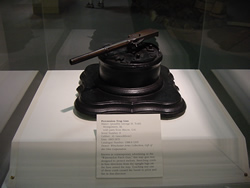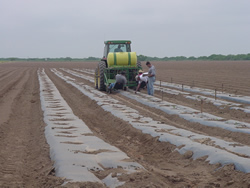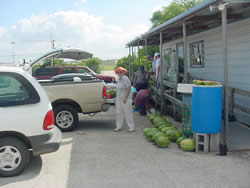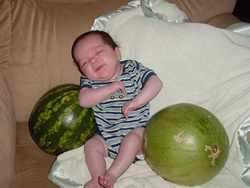SEEDLESS WATERMELON
GOOD EATING TO SOOTHE THE SUMMER HEAT
How watermelon came to North American shores, the origin and
history of this vegetable, and the nutrition and how to harvest
watermelons can be found at:
http://www.plantanswers.com/garden_column/june02/june5.htm
There is nothing that can cool your innards and soothe your displeasure
with a hot summer day better than watermelon. Watermelon is the
sweetest member of that vast family of 700 species called Cucurbitaceae.
Watermelon's closest kin in this family are cucumbers, gourds,
cantaloupes, pumpkins and
squash. All species are indigenous to the tropics and are characterized
by their trailing vines, climbing tendrils and hairy leaves. The
botanical name for watermelon is Citrullus lanatus. The only other
cultivated species in the Citrullus genus is the citron melon,
which has hard, white flesh and is used for preserves and pickling.
The watermelon comes in one of three shapes. It can have a symmetrical
shape that is round as a basketball, oval as a football or stretch
out into an oblong, cylindrical form.
"Red" is another word that seems to define all watermelons.
It's true that in most varieties, the flesh color of watermelons
ranges from light to deep red but several varieties have yellow
or orange flesh. The varieties with unusual flesh color, such
as yellow, taste as sweet and juicy as their red cousins but become
over-ripe much faster than do the red-fleshed types.
I don't know how many of you were raised in a farming community
where watermelons were grown but if you were, I can tell you the
first memory you have when you see a watermelon. The fondest memory
of your childhood experiences with watermelons was sneaking into
your grandpa's or neighbor's field on a hot summer day, busting
the biggest, ripest melon you could find and eating the "heart"
or center out of the watermelon. You didn't seem to mind that
juice running down your face and over your chin---that was living
the "good life" and the best eating in the world. I
can even tell you the name of the watermelon variety you enjoyed
as a child--it was named Black Diamond. The reason you enjoyed
that watermelon experience so much is because the center or "heart"
of those watermelons didn't have any of those pesky seed--just
pure, juicy watermelon. Those were the good old days but scientists
have now improved the annoying seed-spitting problem and created
watermelons which have all "heart" all the way to the
rind. It is referred to as a seedless watermelon and it is sweeter
tasting and firmer-meated than any Black Diamond that ever existed.
This doesn't mean these seedless watermelons will supercede your
childhood memories--remember, half the fun was sneaking into the
watermelon patch and eating the best part of the summer thirst
quencher named watermelon. You also had more taste buds then!!!

Some of the old-timers were SERIOUS about discouraging watermelon
thief
For those who love watermelon but don't want to engage in a seed-spitting
contest with each bite. Seedless watermelons have an oval to round
shape and can have either red or yellow flesh. A seedless watermelon
may have some white seed-like structures that are edible. Don't
think just because these watermelons are seedless that all varieties
are super-sweet and yield lots of watermelons. Nope!! Every seedless
variety is different and performs differently at each planting
site. So growers won't have to do the testing, the Texas Cooperative
Extension conducts tests in all regions of Texas to see which
seedless and non-seedless varieties perform the best in our conditions.
Some of the results and images can be seen at:
http://aggie-horticulture.tamu.edu/plantanswers/vegetables/2003watermelontrials/index.html

Over 40 watermelon varieties are tested each year in several locations
all over the state to determine which are the best for Texas growers.
When conducting these tests, we are often reminded of some historical
warnings about eating too much watermelon. Mediterranean traders
introduced watermelon to Europe where it was known as the "Turkie
Melon." Books from the 16th century show that the sweet thirst
quencher was not looked on with the delight we accord it today.
John Gerard, writing in The Herbal cautions his readers that "This
fruit should be eaten by Europeans with great caution; when taken
in the heat of the day, whilst the body is warm, colics and other
bad consequences often ensue."
If you will closely examine the data provided at the Watermelon
Variety Trial website above, you will realize that each year we
evaluated approximately 25 seedless varieties and 20 standard,
seeded varieties. We use volunteers to do the taste tests and
I try to make all testers understand that if you take one small
bite of 45 watermelons, YOU HAVE LITERALLY EATEN AN ENTIRE WATERMELON!
However, after a hot, sweaty day of sorting watermelon varieties
and then tasting the sweetest, juiciest watermelon meat this side
of Heaven, some of my anxious volunteers (namely Yolanda, Francine
and Liz!) became somewhat ravenous when "tasting" the
first 10 varieties. After these ladies exhibited a rather savage
display of consumption, they spent the rest of the day "enjoying"
the nearest toilet facilities. For some reason they each had an
empty bucket close at hand for the ride back from Crystal City.
We began the watermelon taste testing with over 15 anxious volunteers
----by the time we cut the last sample, only 8 were left standing!

Some of our eager volunteers can't wait to ruin their digestive
systems with wonderful seedless watermelons!
The obvious question asked about growing seedless watermelons
is: "How does one obtain seed for growing a seedless watermelon?"
Obviously, you cannot save seed from a seedless watermelon. So,
where do the seeds come from? Simply stated, the number of chromosomes
(the threadlike bodies within cells
that contain the inheritance units called genes) in a normal watermelon
plant is doubled by the use of the chemical colchicine. Doubling
a normal (diploid) watermelon results in a tetraploid plant (one
having four sets of chromosomes). When the tetraploid plant is
bred back, or pollinated, by a diploid or normal plant, the resulting
seed produces a triploid plant that is basically a "mule"
of the plant kingdom, and it produces seedless watermelons. Seed
of recommended seedless and seeded varieties can be purchased
from the list at:
http://www.plantanswers.com/Articles/GuideToRecVegVars.asp
Poor seed germination is the main problem with growing seedless
watermelons. When planting seed directly into the garden, the
soil temperature should be minimum of 70 degrees F. at a depth
of 4 inches. Soil temperatures below 70 degrees F. will reduce
germination and emergence. If transplants are
grown, which is the recommended practice since each seedless seed
can cost more than a quarter, the greenhouse temperature should
be 75 to 85 degrees F. during the germination period. Sow seeds
into a pre-moistened growing medium and do not water again until
germination occurs. Begin watering, as
needed, after 10 to 15 percent of the seedlings have emerged.
Plants should be ready for transplanting in 3 to 4 weeks. Transplants
should have not more than 3 true leaves (the first et of "fat
leaves" to appear are cotyledons rather than true leaves)
when set in the field. Use of older, larger transplants can cause
slow, stunted growth and poor yields. In-row and between-row spacing
is generally 48 X 80 inches.
The male and female flowers are born separately on the watermelon
plant. Female flowers must be pollinated for fruit to set. Also,
cross pollination must occur between a seedless and a regular
type watermelon for seedless fruit to be produced. Seedless watermelon
plants do not produce enough fertile pollen to make melons. Approximately
one-third of the plants in the garden should be of the standard
or 'pollinator' variety. One pollinator plant should be grown
for every two seedless watermelon plants. The pollinator watermelon
should have a rind color or pattern different from that of the
seedless watermelon. Come harvest time, the gardener can easily
tell which melons have seeds and which don't, based on the differing
rind color. Honey bees are the principal insects that pollinate
watermelons. Pollination is a must, and poor or partial pollination
may result in misshapen fruit and no seedless melons.
When harvesting, the lower side or 'ground spot' of the fruit
should be cream-colored or yellowish. The tendril or 'tail' which
occurs in the axils of leaves (where the leaf attaches to the
vine) along the stem can be used as an indicator of ripeness.
Experienced harvesters say that if the 2 tendrils nearest the
fruit are dry, the seedless watermelon is ripe. It is important
to note that the first few mature melons in the garden may frequently
contain small seeds. This condition is most prevalent under stressed
conditions, such as low soil moisture, insufficient fertilizer,
temperature extremes, or disease pressure, which affect normal
plant development.
Each planting of seedless watermelons actually produces 3 different
types of watermelons -- the regular seeded watermelons (from pollinator
plants), the true seedless melons, and a light-green tetraploid
melon that produces a very limited number of seeds, from which
next year's planting can be made.

Even though just over a month old Cody Knight a chip off of his
granddad's block knows the difference between a seedless triploid
on his left and an imposter tetraploid on his right!
Whole, uncut watermelons will retain their texture and flavor
for a week or more if stored away from sunlight at temperatures
of 50 to 60 F. Lower temperatures may cause a loss of flavor.
Once sliced, the melons may be refrigerated for a few days.
A water content of 90% makes watermelon a low calorie sweet treat.
A 4 by 8 inch slice has only 111 calories which means guilt free
enjoyment along with the benefit of vitamins and minerals. A wedge
of watermelon provides two-thirds of the adult daily requirement
of vitamin C. Compare to an orange, it contains nearly twice as
much vitamin A and has more potassium too.
So get to eating and help yourself cool off during this hot Texas'
summer! If you need to keep your children entertained, look what
you can do with the watermelon's rind.
Three tips to pick out a sweet watermelon
When it comes time to pick the perfect melon, people often make their selection based on three characteristics: presence of seeds or lack thereof, size and ripeness.
Typically, a producer measures the sweetness of a watermelon by their Brix count, a way to measure sweetness. On this scale, measurements of 10 are standard and measurements of 11 are considered very sweet.
According to Juan Anciso, Ph.D., a Texas A&M AgriLife Extension Service vegetable specialist in Weslaco and professor with the Texas A&M College of Agriculture and Life Sciences, this year's Brix count measures watermelon sweetness, especially those from the Rio Grande Valley, off the charts between 11 and 13.
However, just because this year's crop of watermelons is a higher quality, it does not mean the melon you pick will be the best of the bunch. The following three tips will teach you how to pick the best watermelon.
Tip 1: Find the yellow belly, or the field spot
Other than cutting open a watermelon to see the inside, the field spot is perhaps the best indicator of the ripeness. This spot on a melon shows where it was laying on the ground while attached to the vine.
If the watermelon is ripe, the field spot should be a large, yellow patch on one side of the melon. If it is ripe, the color should be a creamy, almost butter-like yellow. The bigger the yellow belly and the creamier the color means the more time the melon spent ripening on the vine. However, if the spot is smaller or looks whiter than yellow, then the melon may not be as ripe.
Tip 2: Tap the underbelly and listen for a deep sound
Another way to find a ripe watermelon is to lightly knock the outside with your knuckles. A ripe melon will have a deeper sound, as opposed to an over-ripe one that will have a more hollow or flat sound. A duller, more hollow sound can mean the flesh is starting to go soft and spoil.
Tip 3: Look for a dull and heavy watermelon
Although it may not be the most photogenic nor the easiest to carry to your car, the best watermelons will be dull in appearance and heavier than the rest. A shiny melon indicates the insides are under ripe.
Also, the best melon of the bunch will most likely be heavier than the rest. On average, a watermelon is 92% water, which makes them so juicy. A heavier melon likely holds more water, which will make it juicier.
|



